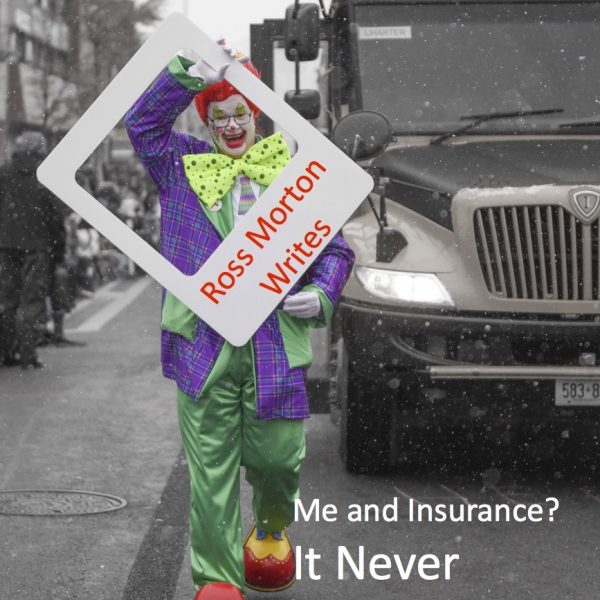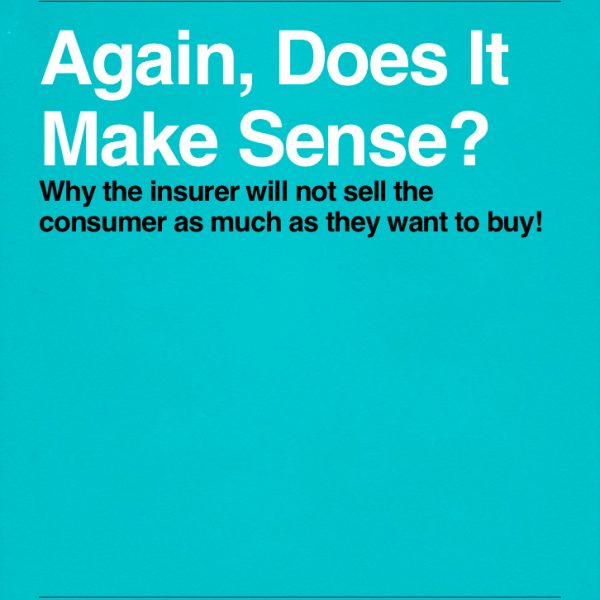I give many lectures and speeches during the year often tailoring the talk to the audience as I go along. Writing the speech out in advance cramps my style and flexibility. Therefore few of my boisterous moments are caught in print format. My PowerPoints are available but they hardly ever attest to what I really said at the spur of the moment in front of an audience. Many ask for copies of what I said afterwards (hopefully not to find a reason to chastise me but rather because I said something worthwhile. My family says to me “Just tape record all your speeches!”
At the annual meeting of the Association of Home Office Underwriters in October Vera Dolan Associate Editor, On The Risk – The Journal of the Academy of Life Underwriting was in the audience and took copious notes on what all speakers on the main stage said. I was truly amazed at how well she could capture the essence of what I said or tried to say. If only Vera had been with me as I gave almost 6 dozen speeches in 2007 and recorded what I said. I could fill my web site with lots of new material — some boring insurance stuff and some controversial and hopefully thought provoking. None of what came out of my mouth would be considered opprobrious but perhaps once captured by Vera would be considered somewhat profound at times.
I followed on stage the world renown Dr. Phil Smalley who gave his customary insight into the world of medical advances and how wonderful they are and will be thus supporting the actuaries vision of cheap mortality rates for all. I was not as kind to the world of insurance as I tried to steer the minds of the audience to the point of challenging the common believe that all is well when in reality the onus on all risk selectors to be faster, cheaper and easier is contra indicative of reality.
The following is reproduced with the very kind permission of the AHOU, On The Risk magazine and most importantly Vera Dolan who without her trained ear and fast penmanship I would not have this summary of what I said to post on my site.
“Mr. Morton said that the myth or reality every underwriter hears from advisor to marketing team to pricing actuary includes:
- Everybody is living longer – just look at all the centenarians (over 4,000 currently worldwide).
- Cancer detection is better and earlier.
- Heart disease is noted earlier and treated.
- There are many more tests and drugs for a variety of impairments.
With the squaring of the life expectancy curve, more “older people” will become applicants for insurance. Insurance product designers will need to consider how risk factor burden and disease prevalence will influence the percent qualifying for preferred. This raises the question of whether we should be focusing on older or younger individuals, a consideration that touches every market.
Pricing for claims has already dropped from a charge of $4 per $1,000 face amount to $0.37 per $1,000. There is no room for mistakes in this kind of pricing. Actuaries are guessing where mortality improvements will be made, and have already accounted for their estimated improvements by lowered prices. However, underwriters have to make this happen.
Many of the gains in life expectancy may be negated by the growing prevalence of obesity and diabetes. It is questionable if underwriters are handling this properly – should we raise premium rates to let the obese/diabetics remain standard, or should we rate them to keep them out of the standard pool? There are also many variables in obesity and diabetes that produce gray areas of risk that underwriters identify daily when underwriting individual cases – such gray areas can kill actuarial assumptions applied to the overall obese/diabetes segment of business. As preferred pricing has been typically set by product actuaries without the input of underwriters or medical directors, the mismatch in knowledge may cause trouble down the road.
Trends in staffing and operations have produced our current underwriting environment:
- We exist in an era of “faster and cheaper;” underwriters have less time and far fewer tools to make quality decisions.
- Underwriters are more expensive than ever, while being far more transient and demanding. However, automation is heavily used currently and is gaining ground, and over 50% of small cases are being handled by remote underwriters.
- Protective value studies are harder to find than a good book; they are not being done due to sales demands and distribution woes.
- Speed pressures have forced underwriters from making around 20 decisions per day to 40 decisions per day. The greater the speed, the more likely that errors will happen.
Fast tools such as prescription history are not always a good substitute for the more valuable (but costly in time and money) attending physician’s statement (APS). Mr. Morton wondered if the underwriter can be fooled by a prescription history, which may lead to more questions and/or APSs. A 2004 study of U.S. automated prescription histories showed the drug history provider had 2.4% hits by case count, but less than 1.2% hits of significance. However, 41.3% of all U.S. residents age 18 to 44 are on at least 1 prescription drug, and 85.4% of those aged 65 and older are on at least 1 prescription drug.
Moreover, knowing what drug was taken does not necessarily indicate why the drug is being taken. Often drugs with multiple uses will require an APS to define what the real impairment at risk is, so the prescription history may cost more in time and effort for those cases. Examples of common drugs used for multiple impairments include:
- Klonopin, used for treating epilepsy OR severe panic attacks.
- Lamictal, used for treating partial seizures OR bipolar 1 disorder.
- Prednisone, used for treating skin disorders OR endocrine disorders OR rheumatic disorders OR collagen diseases OR allergies OR hundreds of different disorders.
Improved knowledge and availability of medical tests will increase the risk of antiselection. People know more about health risks, and therefore will look after themselves better and thus live longer. That is fine, but when people know more, they will also seek definitive diagnoses in ways that make records unavailable to underwriters and buy insurance. They may also buy insurance first and then get the diagnosis. There are medical services in Asia that now offer state-of-the-art medical screening and treatment at far lower prices than available in Western countries – more people are taking advantage of the information to engage in antiselection.
Other sources of antiselection come from legislative mandates to protect privacy and cover certain impairments. In the U.K. there are 13 genetic impairments that cannot be declined for life insurance. This may be an unwelcome message to brokers in the U.S. who might consider having similar legislation passed in the U.S.
In summary, current concerns of underwriters include:
- Legislation as a promoter of antiselection, not as protector of insurance from the unscrupulous.
- Time and expense pressure on underwriting.
- Ongoing smoking, obesity, diabetes and untreated hypertension decreasing gains from mortality improvement.
- Stranger-owned, consortium-owned life policies.
- Assumptions by pricing actuaries that underwriters are so good that the effects of underwriting will last 25 years.
A summary of the “good news” for the underwriter:
- More tests, education, understanding in preventing disease.
- More and better tests to detect disease.
- More options and less invasive organ and body repair and reconstruction.
- The highest number of quality underwriters ever
- Improvement in the timing, frequency and quality of audits
- Improved segmentation (“fine tuning”) of risks
- More automation to bring consistency and speed to underwriting turnaround”
AHOU brings together the people who are responsible directly and indirectly for the mortality results of the insurance industry. Without the prudent categorization of risk according to, at times, the hazy vision of the marketing actuary, the life insurance industry would not have the great mortality and thus profit results it has experienced for decades. At times like any organization AHOU can lose sight of its need to be controversial and an instigator of stability but overall it works and is leading many more individuals to a truly professional approach to the risk selection domain. I am always proud to be asked to present at their meetings and a big supporter of their mandate.
Once again thanks Vera, On The Risk and AHOU for allowing me to post the transcript.

